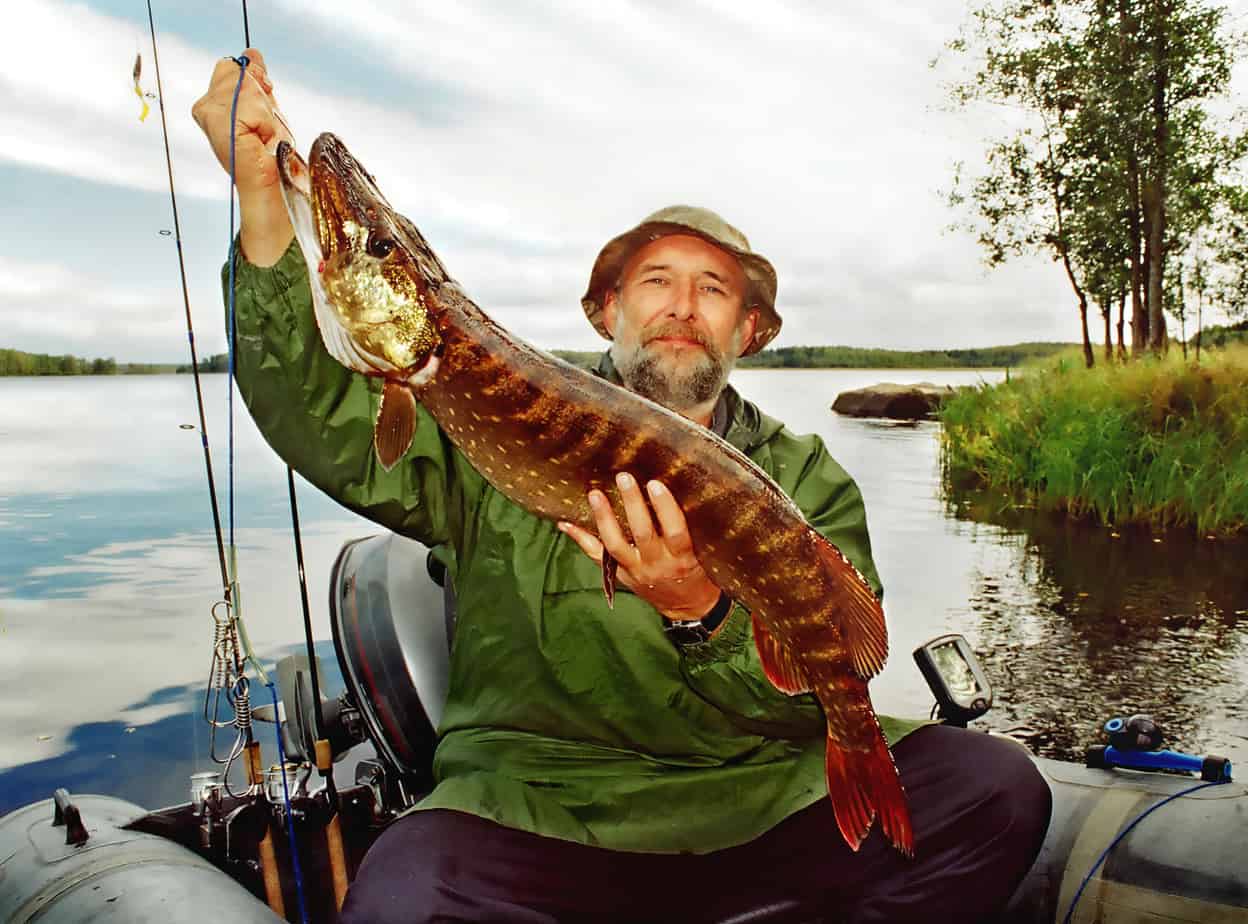Landing a pike is an experience that many anglers dream about. Here in the US, pike are a serious sportsman’s fish. Unlike many other freshwater fish, though, you don’t hear a lot about anglers eating pike. Are pike good to eat?
Pike can be good to eat. Pike are a good source of protein and other nutrients such as vitamin B-12 and vitamin D. It is well-known amongst anglers that pike have a colossal number of bones. Time and care are required to make the pike table worthy, but it is well worth it.
Pike are an adaptable species with a varied diet, and these factors can influence their flavor. However, the consensus is that they have a distinctive taste and delicious flavor so that you will be sampling a tasty fish.
The Best Way To Cook Pike
Preparing Pike
A filleting knife will be needed to prepare the pike ready for cooking. Lay the fish belly side down on a sturdy table. Begin by inserting your knife into the area between the head and gill area. Slice downward until you feel the backbone, then continue cutting the fillet off by angling your knife and slicing down to the tail. Using your knife put the blade between the meat and skin, then using a handler glove, pull the meat as your blade slices off the fillet.
You are now looking for the Y bones on the main carcass, which stick up from the fish’s rib cage. Using your finger, detect where the Y bones are. Then using your knife cut down and around this bone to the bottom of the fish. Repeat with the other side and skin as with the top fillet. Remove any other bones with pliers. Rinse thoroughly underwater and throw the carcass away.
Cooking Pike
Pickled pike is a popular dish. Freeze your prepared pike for 48 hours before use, as this will kill off any parasites in the meat. There are many recipes for brine and pickling liquid, so after choosing one that suits your taste. Cube your pike and put in the cooled brining liquid, leave in the fridge overnight. Drain from the brine, then jar the fish layering with lemon slices, onion, and perhaps bay leaves. Fill the jars with your pickling liquid and seal. Best left for ten days in the fridge before enjoying.
Believe it or not, but pike works well with tropical flavors. Baked with mango, tomato, garlic, and onion is a delicious way of enjoying this fish. Butter a dish, add the fillets, squeeze fresh lemon over the fillets, add salt and pepper. Toss over the vegetables and cover. Cook for about thirty minutes, yum.
Because pike has such firm meat, it is perfect for grilling and barbequing. Either marinate for a few hours or toss the fish with chili flakes, garlic salt, and crushed black pepper before cooking. Ensure the grill is really clean to prevent sticking if barbequing and brush on some oil before cooking. If grilling, oil the pan and make sure you do not have the heat on too high.
Eating Pike
A good accompaniment with pickled pike is fresh bread or some warm rice. Your guests will love it. As with most fish dishes, freshly cooked vegetables are lovely side dishes. Fried zucchini with baby broccoli, sweet potato roasted with pine nuts. The list is endless. And because you have taken the time to ensure your fish has absolutely no bones, you will enjoy the experience of eating this worthy beast.
Other Noteworthy Information
The most important thing to know about pike is, it is chock full of bones.
The many health benefits of eating pike are the nutrients and vitamins it has. A bit of work in preparing this fish is worth it for these benefits.
Facts About Pike
If told they could only fish for one species for the rest of their lives, many anglers would choose pike. This fish is big, aggressive, and fast. Let’s cover some other interesting pike facts that make this such an awesome species.
- Females Are Bigger – If you catch a fish over 18lbs, it is most likely a female. Males rarely grow larger than this.
- Yellow Eyes – Unusual for fish, the pike’s eyes are yellow, sometimes very bright yellow. They also have excellent eyesight.
- Distribution – Pike tend to be prevalent around the temperate band of climate. The northern US and Canada, Scandinavia, and Russia all have populations of pike.
- World Record – A pike caught in Germany in 1986 weighed in at 55lb 1oz and was caught by Lothar Louis.
- Built for Speed – Pike can reach speeds of up to 10mph. The slime usually associated with pike is there to help streamline and smooth their progress through the water.
- Hybrids – In North America, pike have been known to crossbreed with Muskie. The hybrid offspring are known as ‘Tiger Muskie.’
- Diet – If it moves in the water, chances are the pike will eat it: frogs, perch, bass, even small pike.
- Teeth – Pike can have anywhere between 300 and 700 razor-sharp teeth (I can personally testify to the sharpness of their teeth)
- Fishing Season – As a rule, avoid summer when the water is low in oxygen and pike, are lethargic. Spring and fall are the best times, although winter can also be outstanding.
Pike Fishing Tips and Techniques
One of the great things about pike fishing is the sheer variety of techniques that you can use to fish for them. This section shall cover some of the most successful and fun ways to hook this predator.
Where To Fish For Pike
Pike will tend to work the margins of shallow water, look for features like reed beds or lily pads. Chances are a pike is lurking, just waiting to pounce. Also, look for shelves where shallow water suddenly plunges to greater depths. This is another place they love to lurk.
Dead Baiting
Dead baiting, as it sounds, is the practice of using a dead fish as bait. Patience is required with dead baiting, as pike will often study a bait for a long while before being tempted. They have been recorded doing this for around an hour. For the bait itself, eel, perch, bass, trout mackerel, herring, and lamprey can all work. Adding a little sardine oil or other fish oils can help lay a scent down.
Lures, Plugs, and Spinners
Set up your spinning outfit and fish along the margins of reed beds or other areas of vegetation. Rapalas and other plugs work better than spinners in our experience and use a wire trace to avoid losing that valuable kit.
Fly Fishing
A hefty fly rod capable of chucking out large lures and streamers is preferred. Work the same kind of water as with the plugs and spinners. It is hard to hook a pike with a fly due to their mouths’ boniness and the sheer number of teeth they have. Therefore, it is essential to keep your hooks super sharp. If you don’t mind losing the odd fish, then this method is fantastic fun.
Trawling
Trawling along the edges of vegetation that can be reached from the shore is a great way to attract pike. Most types of lures and plugs can work with this method. You can even troll dead baits.
Conclusion
The next time you’re lucky enough to land a pike, you may want to consider if you’re going to make a meal out of it. Pike isn’t for everyone. As stated, pike are boney and require a lot of preparation. If you’re willing to put the time into it, pike can be a fantastic experience that every angler should get to experience at least once.
If you find this article helpful, don’t leave without sighing up for our newsletter and checking out our Recommended Fly Fishing Gear List.
Don’t forget to check out our other Fish Guide articles.
- Are Bass Good To Eat?
- What’s the Difference Between Trout and Salmon?
- Are Bonefish Good To Eat?
- What’s the Difference Between Carp and Buffalo Fish?
- Are Pike Good To Eat?
- The 7 Best Secret Rainbow Trout Baits
- Best Powerbait For Stocked Trout
- What Is The Difference Between Walleye And Pickerel?
- What Is A Tiger Trout? Where to Find One and How To Catch One


